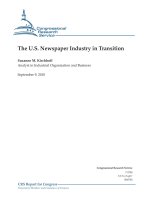Recent U.S. Economic Growth In Charts ppt
Bạn đang xem bản rút gọn của tài liệu. Xem và tải ngay bản đầy đủ của tài liệu tại đây (3.41 MB, 15 trang )
Recent U.S. Economic Growth
MAY 2012
In Charts
The Growth Story Since 2009
GROWTH SINCE 2009
Early May 2010
Cost of borrowing spikes across Europe
Euro falls to four-year low against the dollar
Feb. 2011
Egyptian President steps down
Libyan conflict begins
President Obama ratchets up sanctions on Libya
Oil prices pass $90/barrel
Apr. 15, 2011
Government shutdown
narrowly averted
Oct. 28, 2011
Italian 10y bond yields
close above 6 percent,
remain near or above that
level through late Jan. 2012
Japanese
earthquake/tsunami
Debt limit
European debt crisis
Oct. 2010
Greece, Ireland Portugal
bond spreads widen
1
U.S. DEPARTMENT OF THE TREASURY
Source: Bureau of Economic Analysis, Wall Street Journal.
2008/09 financial crisis
Jul. 2011
Greek, Irish, and Portuguese
spreads spike
Aug. 2011
Oil prices fall
below $90/barrel
Aug. 2, 2011
Debt limit deal reached
Oct. 2011
Oil prices pass $90/barrel
High oil prices High oil prices
Despite the worst financial crisis since the Great Depression and a series of shocks in its
aftermath, the economy has gradually strengthened since mid-2009, though more work remains.
Real quarterly GDP growth
2008 Q4
-8.9%
2009 Q1
-6.7%
2009 Q2
-0.7%
2009 Q3
1.7%
2009 Q4
3.8%
2010 Q1
3.9%
2010 Q2
3.8%
2010 Q3
2.5%
2010 Q4
2.3%
2011 Q1
0.4%
2011 Q2
1.3%
2011 Q3
1.8%
2011 Q4
3.0%
2012 Q1
2.2%
-15
-10
-5
0
+5
+10
Q1
2008
Q2 Q3 Q4 Q1
2009
Q2 Q3 Q4 Q1
2010
Q2 Q3 Q4 Q1
2011
Q2 Q3 Q4 Q1
2012
Personal consumption expenditures
Gross private domestic investment
Exports
Imports
Government consumption and gross
investment
Total GDP growth
+4.3
+3.8
+2.9
-3.5
-0.7
Total
+6.8
-6
-4
-2
0
+2
+4
+6
+8
U.S. economic growth has been led by consumption, private sector investment, and exports.
Percentage point contribution to real quarterly GDP growth, by component
The Components of Growth Since 2009
GROWTH SINCE 2009
Source: Bureau of Economic Analysis.
2
U.S. DEPARTMENT OF THE TREASURY
Cumulative contributions to growth since 2009 Q2,
by component
90
92
94
96
98
1
00
1
02
1
04
Q1
2008
Q2 Q3 Q4 Q1
2009
Q2 Q3 Q4 Q1
2010
Q2 Q3 Q4 Q1
2011
Q2 Q3 Q4 Q1
2012
Growth in the U.S. has outpaced that of other advanced economies affected by the global
financial crisis.
Real GDP, 2008 Q1 = 100
International Growth
GROWTH SINCE 2009
Source: Regional sources (see Notes section).
3
U.S. DEPARTMENT OF THE TREASURY
U.S.
Euro area
Japan
U.K.
Germany
-8%
-6%
-4%
-2%
0%
2%
4%
2006
Q1
'07 '08 '09 '10 '11 '12
0
10
20
30
40
50
60
70
80
'00 '01 '02 '03 '04 '05 '06 '07 '08 '09 '10 '11
-$19.3 trillion
2007 Q2 - 2009 Q1
$80 trillion
Despite challenges, growth in private demand has outpaced GDP growth since late 2010.
Household net worth, inflation-adjusted (constant 2011 dollars)
Wealth, Savings, and Private Demand
UNWINDING THE CRISIS
Source: Federal Reserve Flow of Funds, Bureau of Economic Analysis.
4
U.S. DEPARTMENT OF THE TREASURY
Year-on-year percent change in real GDP and final sales to private domestic
purchasers
0%
1%
2%
3%
4%
5%
6%
7%
8%
80%
90%
100%
110%
120%
130%
140%
150%
'00 '01 '02 '03 '04 '05 '06 '07 '08 '09 '10 '11
Household
debt-to-income
(left axis)
Household
wealth
Household debt and savings as a percent of disposable income
Household wealth has begun to
come back from a sharp decline
in 2007-08, but has not fully
returned
1
…and families are
saving more than
before the crisis.
2
Despite these drags
on spending, private
demand has begun
to show stronger
growth as the
overhang of the
financial crisis fades.
3
Household
savings rate
(right axis)
Growth in final
sales to private
domestic
purchasers
Growth in real
GDP
recession
recession
recession
0.25
0.16
0.02
0.16
-0.08
-0.01
0.01
-0.34
-0.08
0.12
-0.19
-0.37
-0.49
0.05
-0.06
-0.33
-0.41
-0.34
-0.19
-0.26
-0.14
-0.90%
-0.75%
-0.60%
-0.45%
-0.30%
-0.15%
0%
+0.15%
+0.30%
-300
-250
-200
-150
-100
-50
0
+50
+100
2007
Q1
'08 '09 '10 '11 '12
State and local
government
contribution to
real GDP growth
(right axis)
-15%
-10%
-5%
0%
+5%
-3,000
-2,000
-1,000
0
+1,000
'07 '08 '09 '10 '11 '12
Private sector
job growth
(Thousands, left axis)
Private contribution to
real GDP growth
1
(right axis)
State and local governments have been forced to cut deeply and shed jobs in response to fiscal
challenges…
Change in quarterly state and local employment, end-of-period (line, left axis)
Fiscal Drag
Source: BLS, BEA.
U.S. DEPARTMENT OF THE TREASURY
Change in state
and local
employment
(left axis)
State and local government contribution to
real GDP growth, percentage points (bars, right axis)
+100 thousand
UNWINDING THE CRISIS
5
…while private sector growth has continued.
Quarterly private sector changes in employment
and contributions to real GDP growth
Three Misconceptions About Recent Economic Growth
MISCONCEPTIONS
6
U.S. DEPARTMENT OF THE TREASURY
Some analysts have asserted that the following
factors have been impediments to growth:
1.Regulations. Have increased regulations or
regulatory uncertainty been a major factor in
holding back growth?
2.Taxes. Is a high tax burden – or fears of future
tax burdens – impeding growth?
3.Government. Is government so large that it is
getting in the way of private sector-led growth?
But the facts do not support these assertions.
1,100
1,300
1,500
1,700
Jan
2008
'09 '10 '11 '12
Regulations are not impeding business lending or investment.
Commercial and industrial loans outstanding, constant 2011 dollars (log scale)
Are Regulations Holding Back Growth?
MISCONCEPTIONS
Source: Federal Reserve, BEA.
7
U.S. DEPARTMENT OF THE TREASURY
Percent change in real investment in equipment and software 11 quarters after
NBER trough
$1,700 billion
2%
8%
19%
21%
21%
26%
28%
28%
+34%
38%
1980 Cycle
1957-58 Cycle
2001 Cycle
1969-70 Cycle
Average
(excl. 2007-09)
1960-61 Cycle
1973-75 Cycle
1990-91 Cycle
2007-09 Cycle
1981-82 Cycle
Jul. 15, 2010
Wall Street reform enacted
+12%
($144b)
Since Oct. 2010
Commercial
and industrial
loans
600
800
1,000
1,200
1,400
1,600
2007
Q1
'08 '09 '10 '11
Regulations have not dampened corporate profits, even in the industries undergoing significant
regulatory change, such as energy, health care, and finance.
Corporate profits after tax, constant 2011 dollars (log scale)
Are Regulations Holding Back Growth?
MISCONCEPTIONS
Source: BEA, Barclay’s.
8
U.S. DEPARTMENT OF THE TREASURY
S&P 500 Economic Sectors Index, trailing 12-month earnings per share
$1,600 billion
+57%
($570b)
Since 2009 Q1
After-tax
corporate profits
-20
-10
0
10
20
30
40
50
60
70
'05 '06 '07 '08 '09 '10 '11 '12
Consumer Discretionary
Industrials
Utilities
Materials
Telecommunications Services
Information Technology
Consumer Staples
Energy
Health
Care
Financial
recession
recession
12
13
14
15
16
17
18
19
20
21
22
1946 '51 '56 '61 '66 '71 '76 '81 '86 '91 '96 '01 '06 '11
From 2009 to the present, federal revenues relative to the economy have been at their lowest
levels in 60 years.
Total federal revenues as a percentage of GDP (line, left axis)
Is a High Tax Burden Damaging Growth?
MISCONCEPTIONS
Source: OMB, BEA, NBER.
9
22 percent of GDP
Federal
revenues
14.4%
of GDP
1950
15.4%
of GDP
2011
U.S. DEPARTMENT OF THE TREASURY
recession
The President’s Budget proposes new revenues that amount to less than 1 percent of GDP.
Projected revenue raised in the President’s FY2013 Budget and projected cumulative GDP, Fiscal Years 2013 – 2022.
How Large are Proposed Tax Changes?
MISCONCEPTIONS
10
Source: Office of Management and Budget.
U.S. DEPARTMENT OF THE TREASURY
CUMULATIVE
GDP
2013 - 2022
Total new revenue
proposed in
President’s FY2013
Budget, 2013 - 2022
<1% of GDP
Letting the top two income tax brackets return to pre-2001 levels has a minimal impact on
small businesses with employees.
Projected revenue effect of reinstating 36 and 39.6 individual income tax brackets as proposed in the President’s FY2013 Budget, Fiscal Year 2013
Would Proposed Tax Changes Hurt Small Business?
MISCONCEPTIONS
11
Total income of high-income
filers in the top two brackets
2
$1.2 trillion
13% of total income
Total income of high-income filers in the
top two brackets who own small
businesses with employees
3
$400 billion
4% of total income
Small business income of high-
income filers in the top two
brackets who own small
businesses with employees
$113 billion
1% of total income
New revenue
4
from small business income of
high-income filers in the top two brackets who
own small businesses with employees
$2.9 billion
<0.03% of total income
Total income
1
of all filers
$9 trillion
Source: Treasury analysis. See Notes section for methodology.
U.S. DEPARTMENT OF THE TREASURY
0%
1%
2%
3%
4%
5%
'48 '52 '56 '60 '64 '68 '72 '76 '80 '84 '88 '92 '96 '00 '04 '08 '12
Federal employment is at historic lows relative to the overall workforce.
Federal civilian employment as a percentage of the labor force*
Has Government Grown?
MISCONCEPTIONS
Source: OMB, BEA, BLS.
U.S. DEPARTMENT OF THE TREASURY
Federal
civilian
employment
1. 8 %
February 2012
* Periods after 1980 exclude temporary Census workers.
12
recession
Investors remain confident that the U.S. government will meet its real fiscal obligations, as
demonstrated by…
5-year sovereign credit default swap prices
Is There Concern About the Size of Government?
MISCONCEPTIONS
Source: Bloomberg, Federal Reserve Bank of Cleveland, Treasury.
U.S. DEPARTMENT OF THE TREASURY
0
50
100
150
200
250
300
'10 '11 '12
Germany
One-, five-, and ten-year U.S. inflation expectations
-1
0
1
2
3
Jan
2009
'10 '11 '12
France
United States
300 basis points
1-yr inflation expectations
10-yr inflation
expectations
5-yr inflation expectations
3 percent
…low cost of
insurance against
default and…
1
…low inflation
expectations.
2
13
Notes
N
Chart 1
Oil prices are West Texas intermediate crude oil spot prices.
Chart 3
Regional sources
Euro Area: Statistical Office of the European Communities
Japan: Cabinet Office of Japan
U.K.: Office for National Statistics
U.S.: Bureau of Economic Analysis
“Euro Area” consists of the following 17 European Union member countries who have adopted
the euro (European Monetary Union): the 11 original members - Austria, Belgium, Finland,
France, Germany, Ireland, Italy, Luxembourg, the Netherlands, Portugal, Spain - and Greece
(from January 2001), Slovenia (from January 2007), Cyprus and Malta (from January 2008),
Slovakia (from January 2009) and Estonia (from January 2011).
Chart 5
“Private contribution to real GDP growth” defined as the sum of the contributions of real
personal consumption expenditures, real gross private domestic investment, and real exports to
overall annualized quarterly real GDP growth, in percentage points.
Chart 10
1 “Income” defined as adjusted gross income.
Chart 10 cont.
2 “High-income filers” are those who would be subject to the top two individual income tax
brackets under the President’s FY2013 Budget proposal.
3 “Small business owners” defined as filers a) with business income and deductions of less
than $10 million, and b) who employ other individuals. See Knittel et al, “Methodology to
Identify Small Businesses and Their Owners”, Office of Tax Analysis Technical Paper 4, August
2011.
4 “New revenue” includes revenues raised in Fiscal Year 2013 by reversing the
EGTRAA/JGTRAA rate cuts on the top two individual income tax brackets to small business
income of high-income filers who own small businesses with employees.
U.S. Department of the Treasury, Office of Tax Analysis calculations. Revenue estimate excludes
increased revenue that would come from the expiration of other upper-income EGTRAA/JGTRAA
tax cut provisions such as those affecting itemized deductions, personal exemptions, qualified
dividends, and capital gains.
The calculation of the additional revenue from small business employers takes into account the
variation among taxpayers in the importance of small business income. Since the highest
income classes pay most of the added tax but are less dependent on small employer income,
the small employer share of the total tax increase is lower than the small business share of total
income.
U.S. DEPARTMENT OF THE TREASURY









